Come to the Table
Change can be as simple as having dinner together
I’ve been pretty quiet here lately. While I’ve continued to speak around the country about Just Action and be inspired by local efforts to challenge segregation, it’s been hard to focus on them while fair housing laws and funding are being gutted on the federal level.
Instead, as I wrote in my last post recommending Don’t Go: Stories of Segregation and How to Disrupt it, I find myself more interested in sharing content about people building relationships across our divides and taking steps to build the communities they envision are possible, even if policy victories seem far-fetched today.
I recently saw such efforts firsthand at an event called Come to the Table, in Marin City, California.
Sitting across the Golden Gate Bridge from San Francisco, the area was home to a dairy farm until World War II, when housing was quickly built for 6,000 of the 20,000 workers who had come to the region for jobs in nearby shipyards. Dormitories were racially integrated because there was no time to separate the rapid in-migration of black and white jobseekers. But soon, whites were able to access other housing nearby and Marin City became majority-black within almost all-white Marin County.1
Today, Marin City still looks very different than the rest of the county. Its population of 3,000 is 30% African American, while the county’s is less than 3%. Marin County is San Francisco’s wealthy northern neighbor with a median income of $140,000—13th highest in the country. But prosperity doesn’t reach Marin City, where the median income is half that of the county’s. A third of Marin City households earn less than $50,000 and most are renters, while most in the county own their homes.
Not surprisingly, Marin City residents have quite different socioeconomic challenges than their county neighbors. In 2023, that chasm led Pastor Floyd Thompkins of Marin City’s St. Andrew Presbyterian Church to convene faith leaders from around the county for a day of conversations to build support for residents of Marin City. As Pastor Thompkins describes, “we all talked about what we knew, how we knew it, and what we would do about it. It became clear we were living in different worlds.” County faith leaders knew very little about issues that city residents faced, which shocked Pastor Thompkins and his colleagues.
That got him thinking about how to bridge this divide. He saw that it had become harder to connect, that “every system has decided that interpersonal communication is not important. What’s important is voting. What’s important is policy. What’s important is strategy. Whether you know the person is not that important.” He saw that religious leaders could address this missing piece. Soon he started Come to the Table to give people a chance to have one-on-one conversations and get to know each other.
The program is now run by a committee of volunteers from the city and county and is supported by individual donations. Once a month it hosts 25 people from Marin City and 25 from the county to have dinner together. When guests arrive, they are assigned to a table with people they don’t know and that includes a mix of city and county residents. Each monthly dinner focuses on a Marin City challenge or opportunity—education, immigration, policing, health care, the arts, housing—and guests are given prompts to start conversations about those topics. An after-dinner forum includes a speaker who provides greater insight into the month’s theme.
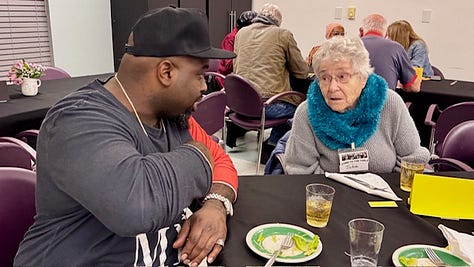
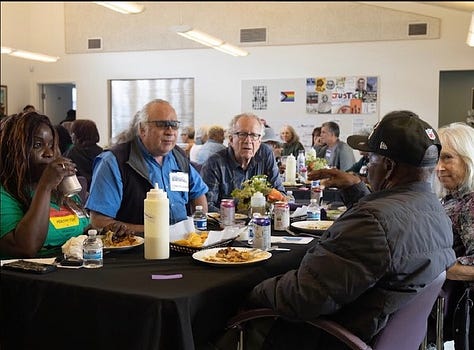
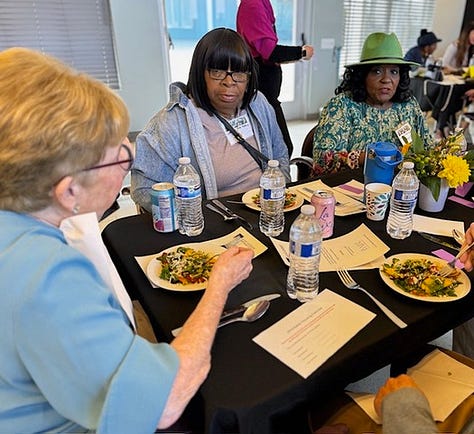
The prompts invite guests to tell a story. Pastor Thompkins explains, “People love to tell stories, and they don't often get a chance to.” The Come to the Table dinner gives them that opportunity. “By the time they get to the forum part of the evening, we have a core group of 50 people who feel connected and who are listening in a different way. And there's something about the spiritual nature of a community when that's happening. It changes the dynamic of the room itself.”
As in Just Action’s description of Winston-Salem’s Presbyterian Inter-Racial Dialogue, Come to the Table hopes that once people connect personally, they develop more understanding, interest, and investment in each other’s experiences and well-being. This can shift something in them, leading to actions that otherwise wouldn’t have been possible.
But staying true to this vision isn’t always easy. “We had to resist activists from both communities who wanted to have conversations that were one dimensional: a political conversation, which is to convince somebody. We're like, ‘no, we're not talking to each other to convince each other.’” This approach – to cultivate relationships and let action naturally follow – is the “secret sauce” of Come to the Table, Pastor Thompkins explains. “If you’re not driven by immediate success, you can become successful, because building community is not something that can happen in a moment. Trust is something that has to happen in a process.
You really have to believe in people and not political consultants. It turns out people do want to work together when they realize the person across from me is not my enemy, but my neighbor. They may be saying reprehensible things, but the important part is why? It might be that they know no one like me, or they could be manipulated by others, or they might believe it, but be open to hear otherwise.”
The organizers hope to see three results from each Come to the Table gathering: people who never knew about the evening’s issue volunteer with a local organization working on it; make donations to support local efforts related to it; and build relationships around it.
It’s working, says Pastor Thompkins. “We've had people give money to certain causes and at least one non-profit started from Come to the Table. People have volunteered with organizations for things they never heard of. And personal relationships have grown.” This is significant, given where each night begins: about 80 percent of attendees from the county had never been to Marin City, although they had lived a few miles away for years. A similar disconnect between Chicago’s North and South sides led Tonika Johnson to start the Map Twins project, profiled in Just Action, and inspired her to team with Maria Krysan in Don’t Go to tell stories of those who crossed segregation’s dividing lines.
Thompkins emphasized that his congregation, with Come to the Table and its other community initiatives, is returning to its roots of relationship-building, and that the rest of the faith community should do so as well, especially if it’s concerned with creating positive community change.
“If anything, what is happening right now is that people have a paucity of imagination of what could be possible. But, when they get around the table, they go, ‘in these stories, we create something.’ In collaboration, you discover courage and bravery. I alone am only so brave. I, in community, get braver. When you think about how people came to be warriors for their cause, every once-in-a-while you get somebody who's brilliant on their own, but for most of us, it is through thoughts, friendships, connections, and then actions.
In American history, it's always the kind of crazy people who make big changes. And we call this American optimism. American optimism believes simply that people can figure this out if we can somehow work together. That is the most optimistic view in world history. It's not that we believe there's something special about America. It's not that we believe in the founding fathers. It's just literally that I believe that if you and I talk, we'll figure how to do something different.
The biggest thing any person can do right now is help people believe that they have the solution and be bold enough to try it. I don't believe that we're without solutions. I think we're without faith in the solutions in ourselves. And honestly, we have to do this quickly because there is a point when none of this works, when we’re too divided to collaborate. And we're getting to that point.”
Pastor Thompkins wants the Come to the Table model to spread. Anyone can recreate it and foster conversations, and he hopes other communities take that on. “The good news is I think enough people are realizing that right now we can have a rebuilding of political community.”
That rebuilding, he explains, starts by saying: “’Let's get unusual people around the table and say, ‘what don't we know? What can we know? And what can we do?’”
Rothstein, Richard. 2017. Color of Law: A Forgotten History of How our Government Segregated America. pg. 29


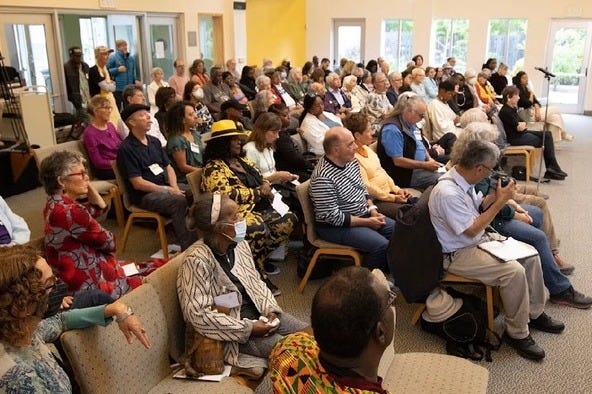
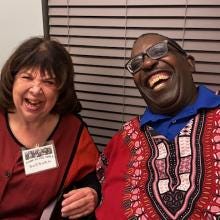
Love this. Are there additional ground rules, besides banning the politcal, one dimensional talk? I imagine some monopolizing the conversation? Not allowing sufficient wait time? Not asking probing follow ups questions because maybe they don't want to hear it?